February 8, 2007
Asymmetric Competition and the CMS
Originally published on theploneblog.org
Beyond the CMS – What are Plone’s greatest future competitors?
I recently encountered O’Reilly’s asymmetrical competition meme and think its a good jumping off point to discuss the differences between Plone’s perceived and actual competition.
First, let’s catch up to where we are today:
Web 2.0 … The Machine is Us/ing Us
The opensource CMS horserace has seemingly settled on a few players, and without provoking any religious wars, I continue to be impressed with the richness and maturity of all of these projects.
But here in the educational sector there are rumblings which I think will spread beyond our corner. In our world ‘C’ stands for Course, not ‘Content’, and the big players are Blackboard (which swallowed WebCT), Sakai and Moodle. Here too, competition may come from surprising corners, as the game itself changes beneath us.
“Collaboration via the net does not necessarily require monolithic, expensive tool suites that aim to do everything under one umbrella. We will share and demonstrate the use of readily available, mostly free, discrete sets of “small” and “loosely joined” technologies – weblogs, wikis, instant messaging, audio/video chat. The loose joining means that how they are connected are not necessarily in the programming of the software, but the ways people can use them in a social context that is an environment of dynamic, changing relationships and connections, rather than the rigid, limited ones defined by computer code.”
from Social software: E-learning beyond learning management systems.
This argument is elaborated on, with many examples of applications that might work this way in this paper:
EMERGING TECHNOLOGIES Tag Clouds in the Blogosphere: Electronic Literacy and Social Networking
So what does this mean for the other sectors where Plone operates? I have been hanging out in Drupal land lately, and for a variety of reasons I don’t consider that platform to be a serious threat to Plone, in the long term (more on that in another post).
On the other hand, and this might raise some eyebrows, folks maybe should take a peek at Gallery 2.2 . Yeah, its in php, and they don’t have enough unit tests, but it does a really nice job of solving the “bucket” problem – that is, easily publishing a repository of digital assets on the web. Their next version will handle audio and video files, and the software is popular enough that people have built desktop clients for iPhoto and Picassa. They have a good story for multi-site installations, upgrades, and even a web based mechanism for upgrading plugins. Just imagine mashing up this backend store with a social-networking tool like elgg. Maybe you could create complex and elaborate views of your data with widgets coming out of the simile project (exhibit and timeline, in particular). You might even be able to use a visual programming tool, like Yahoo’s pipes or IBM’s QEDWiki to assemble this application.
The real threat here isn’t Gallery. Its the loosely-joined, disconnected applications that are becoming connected through the component architecture of HTTP itself (plus a few decent patterns and standards). No one wants to be trapped in a silo, not even if its decked out with hardwood floors, leather furniture, and a marble mantle.
Plone can be a major provider in this hub of communications, maybe even sometimes at the center. But we do need to try to anticipate the future role of the CMS in the face of asymmetric competition.
As Laura Trippi once put it, Content Management Systems like Plone,
are turning content produces into coders, and vice versa. We’re
creating monsters, and they might soon be outgrowing the tools they
were weaned on.
(thanks to Biella for the video reference and the critical commentary).
 Filed by jonah at 10:06 pm under plone
Filed by jonah at 10:06 pm under plone
No Comments

